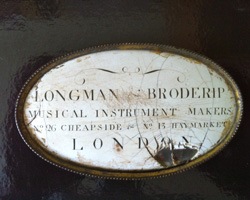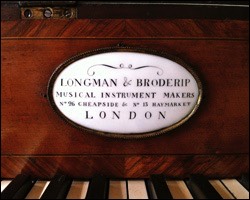1792 Longman & Broderip square piano
You could be forgiven for wondering what on earth this is doing here, but If you’ve got a car with a tatty enamelled radiator badge then read on.

BEFORE
This is the name plate which sits on the front of my 1792 piano and serves the same purpose as the radiator badge - it displays the maker's name. If you have an older car with a scratched and worn-out badge you’ll know how it spoils the “look” of the car.
And so it is with this name plaque; a bit of simple maths will tell you that at 218 years old this is quite a lot older than my 1925 Amilcar. But even so it does look as though it’s come in for a bit of a domestic...
I sent it away to a person up in Diss, Norfolk who more usually repairs clock faces but has done these piano name plates before, as well as instruments for old cars.
I had hoped that he would give me an insight into how he goes about re-enamelling but he explained that he and his father had developed their technique over many years and he wasn’t about to pass it on!
I do understand what he means so we’ll have to make do with this explanation from a different source.
I’ve taken this from a website which was run by the late Allan Heywood, an Australian enameller of world renown.

AFTER
...and I have précised it as follows.
Stage 1 - the removal of old enamel and plating.
Stage 2 - Vitreous enamel is inlayed in the recesses and the piece is fired in a kiln to red heat, about 850 C. This results in surface blackening which is a loosely adhering mixture of copper and zinc oxides. Much can be removed by scrubbing under water but the rest may require ‘pickling’ in 10% sulphuric acid solution
Stage 3 - “Stoning”, an operation which grinds the surface of the fired enamel with the surrounding “cell walls”
Stage 4 - more enamel may be added to fill in low spots and then fired again.
Stage 5 - more “pickling”, “stoning” and perhaps firing followed by polishing and possibly ultrasonic cleaning and plating.
Restoration of previously-enameled emblems is a difficult operation. It takes considerably longer and requires more care and attention to detail to restore an emblem than it took to enamel it in the first place, mainly because of the severely reduced height of the cell walls - caused by “stoning” during the original enamelling.
Since this was first written Allen Heywood has died and I haven't found anyone who describes it so well.
There are of course other enamellers who specialise in car badges such as Pamela David Enamels (badgecraft) and Lewis Badges at http://www.lewisbadges.co.uk/
